Saturday 16th February 2019, 2.00pm to
4.00pm, Pamela Pretty
Demonstration: Pastel Seascape
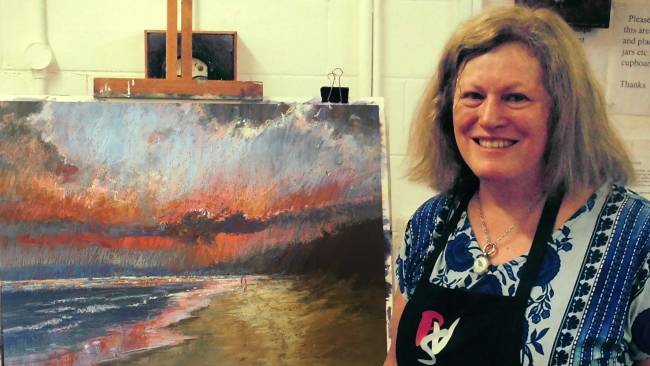
Pamela is a multi -prize winner with her pastel paintings. Vic Pastels count her as one of their stars. She is one of the international awardees in Pastel 100. She has an exhibition at Aireys Inlet in March.
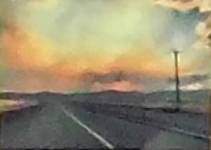 Today, it was something a bit different. She
was looking for an idea to enhance her sea-scape. She was looking
into the light along the beach into a bush-fire sky at Port Fairy.
Today, it was something a bit different. She
was looking for an idea to enhance her sea-scape. She was looking
into the light along the beach into a bush-fire sky at Port Fairy.
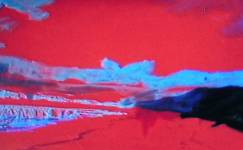 Her back-ground was quite a dark red Colour-Fix paper. It is good
to have a warm ground for a cool coloured painting.
Her back-ground was quite a dark red Colour-Fix paper. It is good
to have a warm ground for a cool coloured painting.
She had a
sketch started. Metho on the paper dissolved the pastel
under-painting which darkens the pastel. The metho fixes the pastel
onto the paper . She had sorted a selection of colours before-hand,
light to dark, warm to cool to neutral. If it looks good in the
palette, it is likely to look good in the picture.
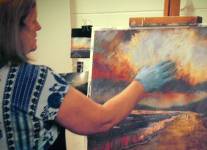 Gloved hands.
(She forgot them after after-noon tea).
Gloved hands.
(She forgot them after after-noon tea).
She started by putting in the underneath colours , setting up for later. A lot gets covered up in the long-run, but is important. The lightest light against the darkest dark equals the tonal range, especially when looking into the light.
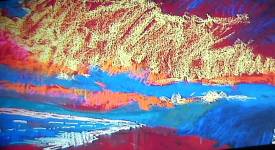 She explained high chroma versus low
chroma (the intensity of pigment or colour). She knew clearly what
her intent was as was able to explain it, even if the early stages
of the painting did not make it obvious to the audience. Put
down high chroma colours first, otherwise it becomes muddy. She
sees herself as a colourist. She
She explained high chroma versus low
chroma (the intensity of pigment or colour). She knew clearly what
her intent was as was able to explain it, even if the early stages
of the painting did not make it obvious to the audience. Put
down high chroma colours first, otherwise it becomes muddy. She
sees herself as a colourist. She
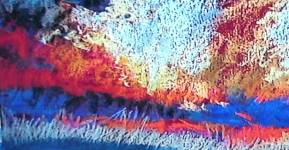 wanted to include a couple of
figures. Not large or precise. Carrot people and footprints. This
made the scene clearer to the audience. Dunes and trees on the
right began to emerge. She was well able to keep up a commentary of
what she was doing. She obviously had a firm idea of where she was
going, even if we did not.
wanted to include a couple of
figures. Not large or precise. Carrot people and footprints. This
made the scene clearer to the audience. Dunes and trees on the
right began to emerge. She was well able to keep up a commentary of
what she was doing. She obviously had a firm idea of where she was
going, even if we did not.
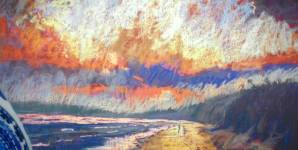 Now to blend the sky into a unity. A
bush-fire sky. Light turquoise with the red coming through. She
said it was very therapeutic to do. The colour of the back-ground
paper is very important. The colour of a pastel turns out
differently on different papers.
Now to blend the sky into a unity. A
bush-fire sky. Light turquoise with the red coming through. She
said it was very therapeutic to do. The colour of the back-ground
paper is very important. The colour of a pastel turns out
differently on different papers.
Her technique is virtually a three or more layered one. You have to know what your ultimate colour is going to be, but not put it down at first. The eye blends the layers. Not too much rubbing which results in one colour and loses the coloured ground paper. To blend, she uses conte’s, hard pastels also useful as a shaping tool to adjust edges. To neutralise a bright colour, overlay it with a complementary colour, which greys it off. The technique allows you to work a lot over the picture and still end up with a loose effect.
Thank you Pamela for generously sharing with us your pastel technique.
Copyright
© 2019
Whitehorse Arts Association
All rights reserved.